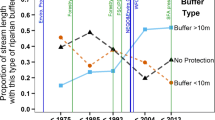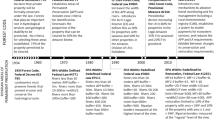Abstract
Commercial afforestation in South Africa dates back to the 1870s and started as an alternative to the fast disappearing indigenous timber resource. It involves the planting of exotic timber species and has impacts on water resources, soil biodiversity, landscapes, etc. Commercial afforestation of land has been subjected to regulation through the Afforestation Permit System (APS) since 1972, primarily to protect the national water resource. Since the APS no longer adequately dealt with afforestation regulation, it was replaced in 1999 with a procedure that was supposed to integrate the requirements of relevant legislation and general environmental management principles. This paper is a theoretical review of the background and development of the new South African Streamflow Reduction Activities licensing procedure, as well as whether it complies with the requirements of an environmental management system such as ISO 14001. The main conclusion is that the new procedure, although an improvement on the previous procedure, still has shortcomings especially with regard to the operational and decommissioning phases of forestry in South Africa. It is recommended that these aspects be addressed in order to mitigate the impact of forestry on water sustainability in South Africa.
Similar content being viewed by others
References
Allen D.G., Harrison J.A., Navarro R.A., Van Wilgen B.W. and Thompson M.W.,1997:The impact of commercial a forestation on bird populations in Mpumalanga Province, South Africa:Insights from Bird-Atlas data. Biological Conservation 79:173–185.
Alletson D.J., 1998:Integrated Environmental Management in the A forestation Planting Permit Process:A review of the process and guidelines for its future implementation. Unpublished report done on behalf of Umgeni Water,Durban.55 pp.
Armstrong, A.J.,1996:Effects of pine afforestation on native biota and conservation evaluation of afforestable grasslands in montane areas of South Africa.Ph.D.Thesis.Stellenbosch,University of Stel-lenbosch.182 pp.
Armstrong A.J., Benn G., Bowlamd A.E., Goodman P.S., Johnson D.N., Maddock A.H.and Scott-Shaw C.R.,1998:Plantation forestry in South Africa and its impact on Biodiversity.Southern African Forestry Journal 182:59–65.
Branch K., Hogrer D.A., Thompson J.and Creighton J.,1984:Guide to Social Assessment:A Framework for assessing Social Change. London, Westview Press.
Constantini A., Dunn G.M.and Grimmett J.L.,1997:Towards sustainable management of forest plantations in south-east Queensland.II:Protecting soil and water values during second rotation Pinus plantation management.Australian Forestry 60 (4): 226–232.
De Bruyn P.H.,2002:Personal communication to author.
Department of Environment Affairs (DEA),1992:The Integrated Environmental Management Procedure.Pretoria.19 pp.
Department of Environmental Affairs and Tourism (DEAT),1998: Guideline Document:EIA Regulations.Implementation of Sections 21,22 and 26 of the Environment Conservation Act.,April 1998, Pretoria.48 pp.
Department of Water Affairs (DWA),1986:Management of the Water Resources of the Republic of South Africa,Pretoria.
Department of Water Affairs and Forestry (DWAF), 1996:The Philosophy and Practice of Integrated Catchment Management: Implications for Water Resource Management in South Africa.Department of Water affairs and Forestry and the Water Research Commission, Pretoria (WRC Report No TT 81/96).140 pp.
Department of Water Affairs and Forestry (DWAF),1997:South Africa 's National Forestry Action Programme,Pretoria.148 pp.
Department of Water Affairs and Forestry (DWAF),2000:Water Conservation and Demand Management Strategy for the Forest Sector in South Africa. Pretoria, DWAF.
Department of Water Affairs and Forestry (DWAF), 2002:National Water Resource Strategy.Pretoria, DWAF.
Du Plessis W., Baloyi T., Louw H.J.and Potgieter,S.,1997: Environmental Legislation and the Environmental Conservation Act.Unpublished assignment.Department of Geography and Environmental Studies,Potchefstroom University for Christian Higher Education, Potchefstroom.28 pp.
Ferrier R.C., Whitehead P.G.and Miller J.D.,1993:Potential impacts of afforestation and climate change on the stream water chemistry of the Monachyle catchment.Journal of Hydrology 145:453–466.
Forest Stewardship Council (FSC),1994:Principles and criteria for natural forest management.Information Brochure.Oaxaca, Mex-ico.9 pp.
Forsyth G.G., Versfeld D.B., Chapman R.A.and Fowles B.K.,1997: The Hydrological implications of a forestation in the North-Eastern Cape:A survey of resources and assessment of the impacts of land-use change.Report No:511/1/97. Water Research Commission, Pretoria.134 pp.
Fuggle R.F.and Rabie,M.A.(eds),1996.Environmental Management in South Africa.Cape Town, Juta & Co,Ltd.823 pp.
Grut M.,1997:Notes on the history of forestry in the Western Cape 1652–1872.Southern African Forestry Journal 100:32–37.
Gilpin A.1996:Environmental Impact Assessment:Cutting Edge for the Twenty-First Century. Cambridge University Press.
Glasson J.and Heaney D.,1993:Socio-economic impacts:The poor relations in British environmental impact statements.Journal of Environmental Planning and Management 36 (3):335–406.
Heydenrych B.,1995:Forestry plantations vs biodiversity:Is a win-win situation possible.Veld and Flora 81 (1):2021.
Hewlett J.D.and Hibbert A.R.,1961:Increases in water yield after several types of forest cutting.Int.Assoc.Sci.Hydro. 6:5–17.
Hibbert A.R.,1967:Forest treatment effects on water yield.In:Sopper W.E.and Lull H.W. (eds),Forest Hydrology. New York, Pergamon Press. pp.527–543.
Inter-organizational Committee,1994:Guidelines and principles for social impact assessment.Impact Assessment, 12 (2):107–152.
Johnson R.,1998.The forest cycle and low river flows:A review of UK and international studies.Forest Ecology and Management 109:1–7.
Kromhout C.,1994:Hoe raak bosbou die omgewing.Arbor 1 (4):10–11.
Kruger F.J.and Everard, D.A.,1997:The sustainable management of the industrial plantation forests of South Africa:Policy development and implementation.Southern African Forestry Journal 179:39–44.
Lesch W.,1995:The development of guidelines for the design of streamwater quality monitoring strategies in the forestry industry. Report to the Water Research Commission on the project, ''Development of a rule model for the design of streamwater quality monitoring strategies in the forestry industry.WRC Report No.524/1/95.Water Research Commission,Pretoria.
Marais G. van R.,1991:Die estetiese aspekte van kommersiele bosbou bedrywighede in die landskap.Magistwin Thesis Pretoria:Univer-sity of Pretoria.102 pp.
Miller G.T.,1994:Living in the Environment:Principles,Connections and Solutions.Belmont,California, Wadsworth Publishing Com-pany.701 pp.
Mitchell B.1990:Integrated water management.London: Belhaven Press.225p.
Mwendera E.J.,1994.Effect of the water yield of the Luchelemu catchment in Malawi of replacing indigenous grasses with timber plantations.Forest Ecology and Management 65:75–80.
Newson M.,1992:Land, Water and Development.New York, Routledge.351 pp.
Olbrich K., Christie S.I., Evans J., Everard D., Olbrich B.and Scholes R.J.,1997:Factors influencing the long term sustainability of the South African Forest Industry. Southern African Forestry Journal 178:53–58.
Primack R.B.,1993:Essentials of Conservation Biology.Massachu-setts,USA: Sinauer Associates Inc.564 pp.
Republic of South Africa,1969:National Monuments Act, no.28 of 1969.Pretoria, Government Printer.
Republic of South Africa,1983:The conservation of Agricultural Resources Act,no.43 of 1983. Pretoria, Government Printer.
Republic of South Africa, 1984:Forest Act,no.122 of 1984. Pretoria, Government Printer.
Republic of South Africa, 1989:Environment Conservation Act,no. 73 of 1989.Pretoria, Government Printer.
Republic of South Africa (RSA), 1996:The Constitution of the Republic of South Africa,no.108 of 1996.Pretoria, Government Printer.
Republic of South Africa (RSA),1997a:The identification under section 21 of activities which may have a substantial detrimental impact on the environment.Government Notice R1182. Government Gazette no.18261. Pretoria, Government Printer.
Republic of South Africa (RSA),1997b:Regulations regarding activities identified under section 21(1).Government Notice R1183. Government Gazette no.18261. Pretoria, Government printer.
Republic of South Africa (RSA),1998a:National Water Act,no.36 of 1998.Pretoria, Government Printer.
Republic of South Africa (RSA),1998b:National Forest Act,no.84 of 1998.Pretoria, Government Printer.
Republic of South Africa (RSA),1998c:National Environmental Management Act,no.107 of 1998.Pretoria, Government Printer.
Richardson D.M.,1998:Forestry Trees as Invasive Aliens.Conserva-tion Biology 12 (1):18–26.
Scott D.F., Le Maitre D.C. and Fairbanks D.H.K.,1998:Forestry and stream flow reductions in South Africa:A reference system for assessing extent and distribution.Water SA 24 (3):187–199.
Smith R.E. and Scott D.F. 1992:The effects of afforestation on low flows in various regions of South Africa.Water SA 18 (3):185–194.
South African Bureau of Standards (SABS),1996:ISO 14004:1996, Environmental Management Systems:General guidelines on principles,systems and supporting techniques,Pretoria. 31 pp.
South African Forestry Company Limited (SAFCOL),1998:SAF-COL 's FSC Certi cation Programme:Progress Report Nr.2 of March 1998,Sabie.3 pp.
Van der ZeI D.W.,1989:Strategic forestry development plan for South Africa.Directorate for National Forestry Planning,Department of Forestry, Pretoria.
Van der ZeI D.W.,1995:Accomplishments and dynamics of the South African A forestation Permit System.Southern African Forestry Journal 172:49–58.
Van der ZeI D.W.,1997:In pursuit of sustainable forestry develop-ment.Southern African Forestry Journal 180:55–60.
Van Wyk J.J.,2001:Relationships between catchment management and environmental management systems.MSc Dissertation.PU for CHE,Unpublished.
Versfeld D.B. and Van Wilgen B.W., 1986:Impact of woody aliens on ecosystem properties.In: Macdonald I.A.W., Kruger F.J. and Ferrar, A.A. (eds), The Ecology and Management of Biological Invasions in Southern Africa. Cape Town, Oxford University Press. pp.239–246.
Versfeld D.B.,1996:Forestry and water resources:policy development for equitable solutions.Southern African Forestry Journal 176:55–59.
Verster E., Du Plessis W., Schloms B.H.A. and Fuggle R.F.,1996:Soil. In: Fuggle R.F.and Rabie M.A. (eds),Environmental Management in South Africa. Kenwyn, Juta and Co. Ltd. pp.181–211.)
Warren M.H.H.,1998:The ''New'' A forestation Permit System (APS). Arbor, Final Issue. 1998:6–7.
Warren M.H.H.,1999:Department of Water Affairs and Forestry. Stream flow Reduction Activities:Combined Licensing and Author-isation Guidelines,Pretoria.
Wicht C.L.,1949:Forestry and Water Supplies in South Africa. Bulletin 33,Dept.of Forestry.Pretoria, Government Printer.
Author information
Authors and Affiliations
Rights and permissions
About this article
Cite this article
Van der Walt, I.J., Struwig, A. & van Rensburg, J.R.J. Forestry as a streamflow reduction activity in South Africa: Discussion and evaluation of the proposed procedure for the assessment of afforestation permit applications in terms of water sustainability. GeoJournal 61, 173–181 (2004). https://doi.org/10.1007/s10708-004-2872-7
Issue Date:
DOI: https://doi.org/10.1007/s10708-004-2872-7




